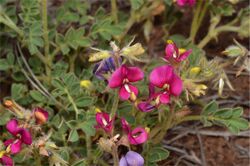Biology:Swainsona flavicarinata
| Swainsona flavicarinata | |
|---|---|

| |
| In Tjoritja / West MacDonnell National Park | |
| Scientific classification | |
| Kingdom: | Plantae |
| Clade: | Tracheophytes |
| Clade: | Angiosperms |
| Clade: | Eudicots |
| Clade: | Rosids |
| Order: | Fabales |
| Family: | Fabaceae |
| Subfamily: | Faboideae |
| Genus: | Swainsona |
| Species: | S. flavicarinata
|
| Binomial name | |
| Swainsona flavicarinata J.M.Black[1]
| |
Swainsona flavicarinata is a species of flowering plant in the family Fabaceae and is endemic to inland areas of continental Australia. It is a prostrate to more or less erect perennial herb, with imparipinnate leaves with 5 to 9 egg-shaped leaflets with the narrower end towards the base, and racemes of purple, red or pink flowers in racemes of 3 to 15.
Description
Swainsona flavicarinata is a prostrate to more or less erect perennial herb, that typically grows to a height of about 45 cm (18 in) and has densely softly-hairy stems. The leaves are imparipinnate, mostly 20–60 mm (0.79–2.36 in) long with 5 to 9 egg-shaped leaflets with the narrower end towards the base, the leaflets 10–15 mm (0.39–0.59 in) long and 5–10 mm (0.20–0.39 in) wide with lance-shaped stipules 4–7 mm (0.16–0.28 in) long at the base of the petioles. The flowers are purple, red or pink, arranged in racemes of 3 to 15, each flower 5–10 mm (0.20–0.39 in) long on a pedicel 3–4 mm (0.12–0.16 in) long. The sepals are softly-hairy, joined at the base to form a tube, with teeth 3 or more times longer than the tube. The standard petal is 8.5–11 mm (0.33–0.43 in) long, the wings 7.2–9.6 mm (0.28–0.38 in) long and the keel 8–10.5 mm (0.31–0.41 in) long. Flowering usually occurs from June to October, and the fruit is an oval to oblong pod 10–15 mm (0.39–0.59 in) long on a very short stalk, with the remains of the style about 4 mm (0.16 in) long.[2][3][4][5][6]
Taxonomy and naming
Swainsona flavicarinata was first formally described in 1924 by John McConnell Black in the Flora of Australia.[7] The specific epithet (flavicarinata) means "yellow-keeled".[8]
Distribution
This species of pea usually grows near watercourses or floodplains near creeks or rocks holes in inland Australia, mostly in the Northern Territory, but there are also records from South Australia, Queensland and New South Wales.[2][3][4][5][6]
References
- ↑ "Swainsona flavicarinata". Australian Plant Census. https://biodiversity.org.au/nsl/services/apc-format/display/77348.
- ↑ Jump up to: 2.0 2.1 Thonpson, Joy (1993). "A revision of the genus Swainsona (Fabaceae).". Telopea 5 (3): 529–530. https://www.biodiversitylibrary.org/item/264754#page/106/mode/1up. Retrieved 6 January 2024.
- ↑ Jump up to: 3.0 3.1 "Swainsona flavicarinata". State Herbarium of South Australia. http://www.flora.sa.gov.au/cgi-bin/speciesfacts_display.cgi?form=speciesfacts&name=Swainsona_flavicarinata.
- ↑ Jump up to: 4.0 4.1 Thompson, Joy; James, Teresa A.. "Swainsona flavicarinata". Royal Botanic Garden, Sydney. https://plantnet.rbgsyd.nsw.gov.au/cgi-bin/NSWfl.pl?page=nswfl&lvl=sp&name=Swainsona~flavicarinata.
- ↑ Jump up to: 5.0 5.1 "Swainsona flavicarinata". Northern Territory Government. http://eflora.nt.gov.au/factsheet?id=2456.
- ↑ Jump up to: 6.0 6.1 "Swainsona flavicarinata'". FloraBase. Western Australian Government Department of Parks and Wildlife. https://florabase.dpaw.wa.gov.au/browse/profile/4227.
- ↑ "Swainsona flavicarinata". Australian Plant Name Index. https://biodiversity.org.au/nsl/services/rest/instance/apni/491365.
- ↑ Sharr, Francis Aubi; George, Alex (2019). Western Australian Plant Names and Their Meanings (3rd ed.). Kardinya, WA: Four Gables Press. p. 200. ISBN 9780958034180.
Wikidata ☰ Q15484891 entry
 |

